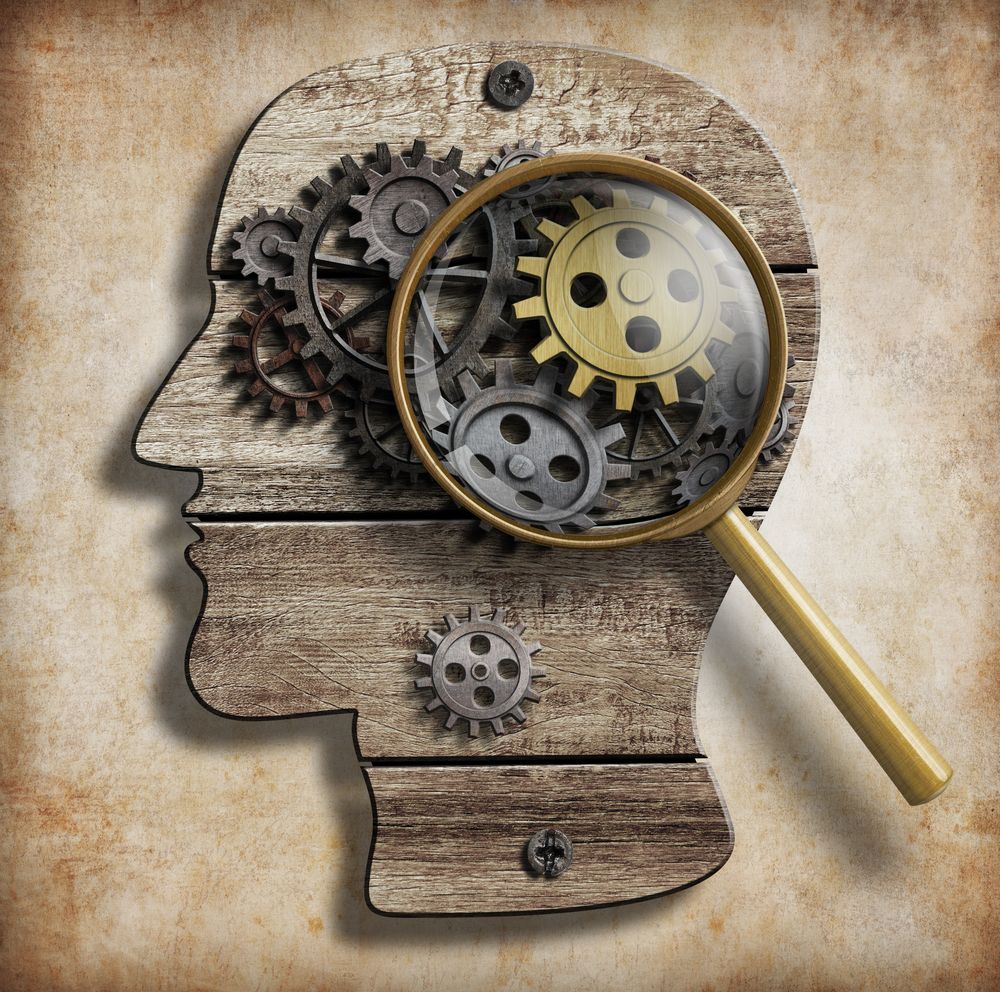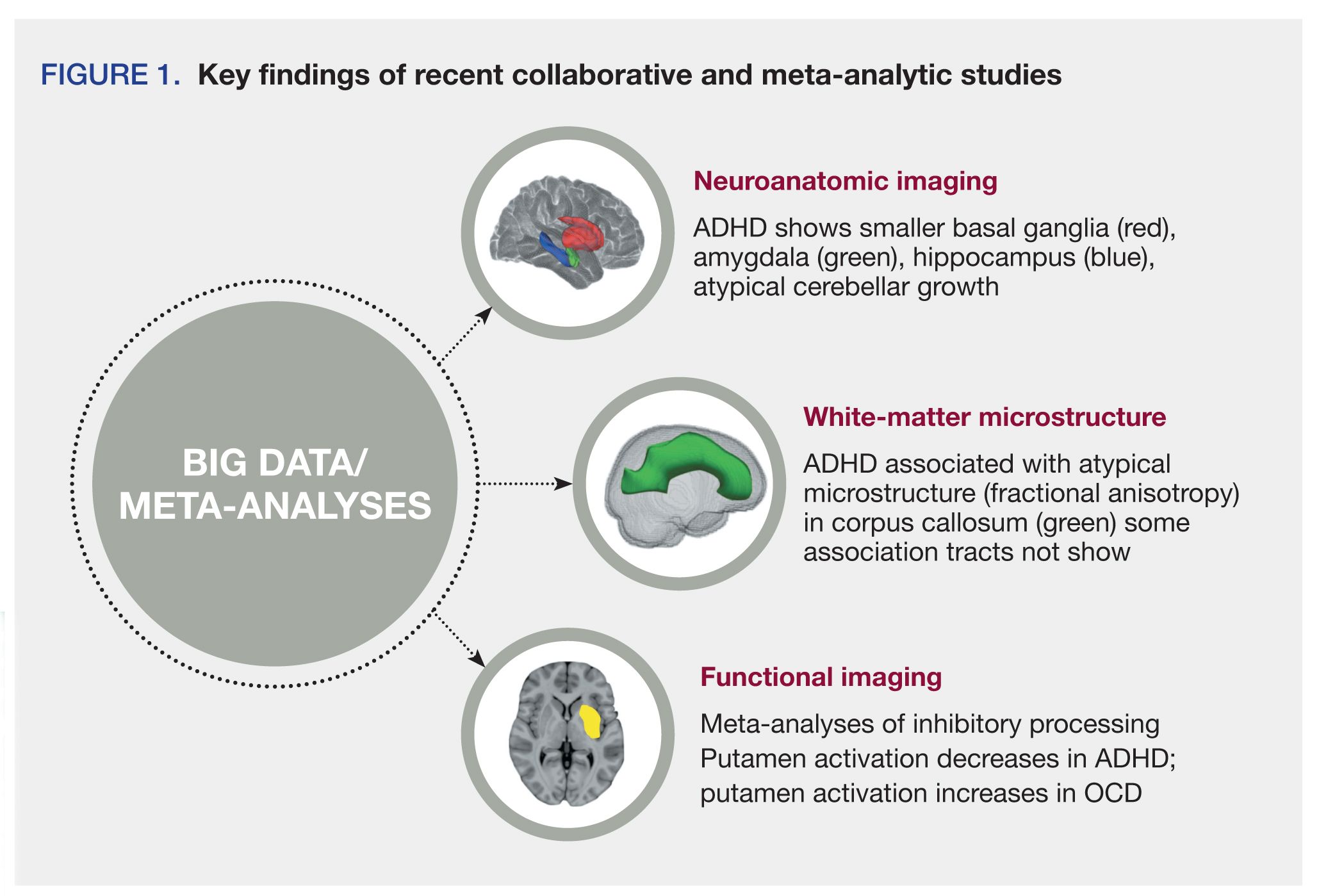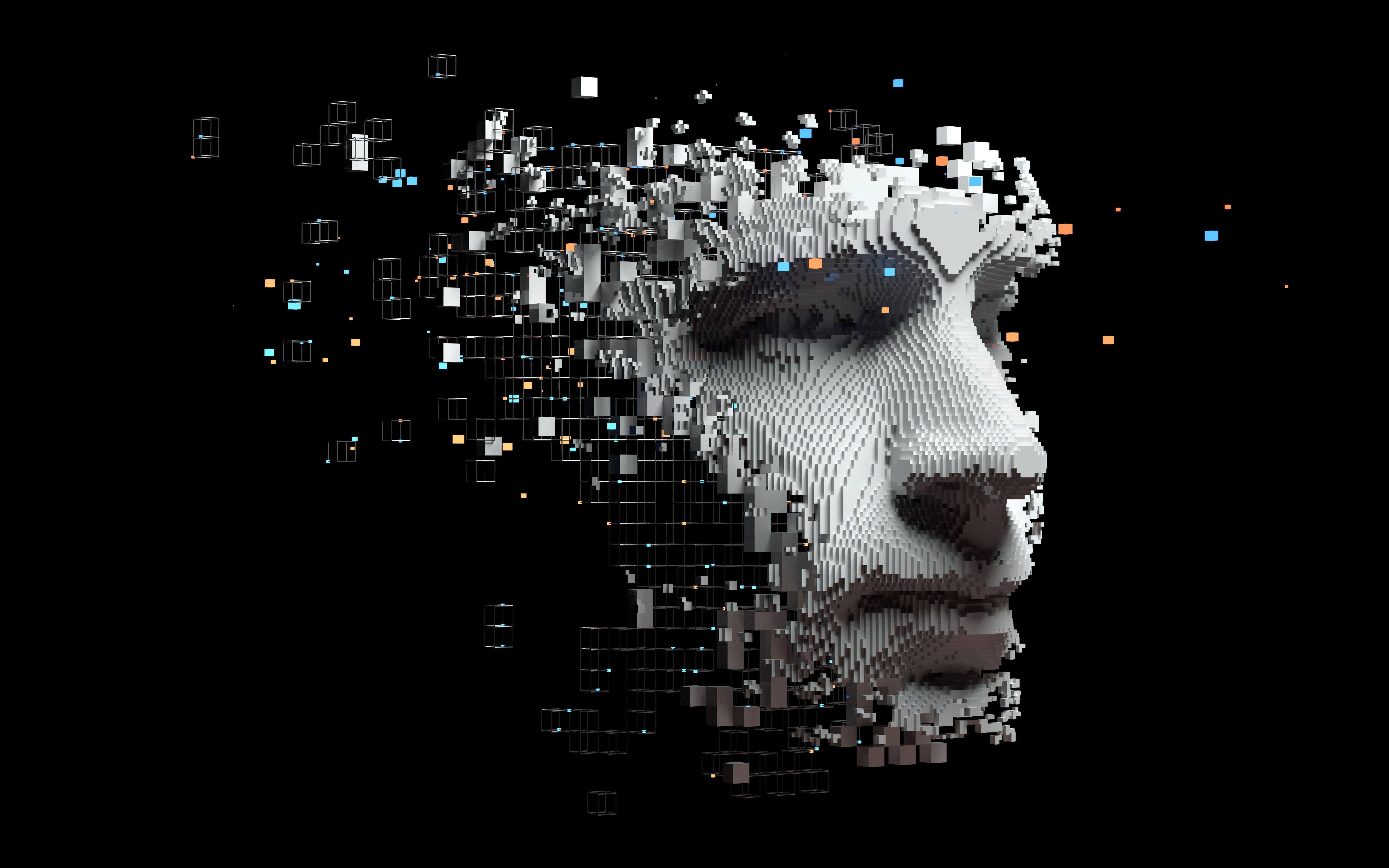Publication
Article
Psychiatric Times
ADHD Neuroimaging: What’s New?
Author(s):
These three recent trends in ADHD neuroimaging may lead to objective tools for diagnosis as well as stimulate discovery of novel therapeutics.
Audrey Kuzmin/Shutterstock

SIGNIFICANCE FOR PRACTICING PSYCHIATRISTS

FIGURE 1. Key findings of recent collaborative and meta-analytic studies

FIGURE 2. Key findings of recent studies of the neural substrates of different adult outcomes of childhood ADHD

Neuroimaging provides a window into the developing brain, allowing us to examine safely and noninvasively brain anatomy, function, biochemistry, and connectivity. When applied to neurodevelopmental disorders, such as ADHD, imaging in vivo could provide objective tools to inform diagnosis, prognosis, and stimulate discovery of novel therapeutics. In this article, three recent important trends in ADHD neuroimaging are highlighted: (1) the rise of big data in ADHD imaging; (2) how neuroimaging has expanded its focus from children to include adults; and (3) efforts to translate neuroimaging into clinical tools. This review is selective and provides a narrative rather than quantitative synthesis of recent literature.
Big data and genetic imaging
As clinicians know, the diagnosis of ADHD encompasses a wide range of clinical presentations, from the distracted day-dreamy child to the exceptionally impulsive hyperkinetic teen. This clinical heterogeneity is a major challenge for imaging studies, particularly those with small sample sizes-different clinical presentations are unlikely to have identical underlying neural substrates. This source of heterogeneity is compounded by the fact that different study centers often use different scanners, imaging protocols, and analytic approaches.
One strategy for dealing with some of this heterogeneity is to combine the data from multiple studies, thus providing a quantitative summary that will highlight the more robust ADHD-associated differences (Figure 1). One meta-analysis incorporated cross-sectional data from 1713 individuals with ADHD and 1529 unaffected controls and found smaller subcortical structures in patients with ADHD compared with controls, more pronounced in childhood than adulthood.1
A similar collaborative effort used longitudinal imaging data from four cohorts to chart diagnostic differences in the growth of the cerebellum, a pivotal structure in movement, cognition, and emotion.2 Findings indicate that across these cohorts, the ADHD group showed slower growth of cerebellar white matter in early childhood, but faster growth in late childhood. Other meta-analyses have considered the white matter tracts connecting different brain regions and report focal alterations to the corpus callosum and other association tracts.3,4
Several key points emerge when considering these large, meta-analytic studies. The neural differences between youths with ADHD and youths without, while highly significant are associated with small to medium effect sizes. This means that although the distributions of a given brain feature in the ADHD and comparison groups are shifted apart, the distributions still overlap substantially.
These effect sizes are ubiquitous in psychiatric imaging and limit the application of neuroimaging to the individual. Nonetheless, such meta- analytic findings can give powerful insights into neurobiology, particularly when contrasts are drawn across diagnoses. For example, comparative meta-analyses find that while ADHD is associated with decreased volume and hypoactivation during inhibitory processing in the putamen and insula, obsessive compulsive disorder shows the reverse.5 Such dissociations, emerging through the meta-analyses on thousands of subjects, are particularly powerful pointers to key neural circuits in different disorders.
Meta-analyses have their challenges. Statistical approaches can attenuate but do not completely remove the heterogeneity arising from differences in data acquisition between study centers. However, the field is advancing with a greater focus on harmonizing protocols and hardware across centers, developing methods to compensate for artifacts (such as those arising from in-scanner motion), and ensuring quality control procedures are uniform and objective.
Large samples, only attainable through collaboration, are critical for unraveling the etiology of ADHD, which is highly heritable (around 70% of the phenotype is under genetic control).6 A recent landmark was attained with the discovery of common genetic variants that conferred risk for the diagnosis at a genome wide level of significance.7 Each genetic variant confers tiny amounts of risk and thus large cohorts are needed to define which facets of the brain and cognition lie in the causal chain between genetic risk and ADHD symptoms.
The brain might itself provide phenotypes for future gene discovery, specifically neural features that are both heritable (and thus under genetic control) and strongly associated with ADHD.8 This goal can be attained by studying multigenerational, extended families with many members affected by ADHD. Using this approach, connectivity patterns within the cognitive network and its white matter tracts (specifically, the superior longitudinal fasciculus) emerge as both highly heritable and associated with symptoms.
ADHD imaging throughout the lifespan
There is increased recognition that ADHD is not just a disorder of childhood: approximately 20% will continue to have the full syndrome into adulthood, approximately 50% continue to have impairing symptoms, and the remainder have symptom remission.9 Understanding the neural mechanisms that underpin this variability in the adult outcomes of childhood ADHD can inform novel treatment approaches and might provide biomarkers to help predict outcome.
Why do symptoms remit in some children by adulthood, whereas in others, symptoms persist? One possibility is that symptom remission in adulthood is due to the correction of childhood neural anomalies, whereas clinical persistence is tied to the persistence of neural anomalies. Alternatively, remission might arise from neural reorganization as novel systems are recruited to help the individual compensate for core deficits of ADHD. These two models make different predictions about the “remitted” brain.
In the first model, neural features in those with symptom remission will resemble those seen among individuals never affected by ADHD. If, however, neural reorganization and compensation drives remission, then the “remitted” brain will differ from the never affected, albeit in potentially beneficial ways. Finally, it is also possible that some anomalies that reflect the childhood presence of ADHD could persist, regardless of clinical recovery. By this reckoning, both those who have symptom remission and those with symptom persistence will show very similar atypical neural features, despite different clinical presentation.
This question has been tackled by several cohort studies that have assessed children clinically as they grew into adulthood (Figure 2). Most neuroimaging was obtained only at the adult endpoint as many techniques were not widely used when the participants were children. These studies found that adults with persisting ADHD symptoms showed neural anomalies, often resembling those reported in other childhood studies.
What about the neural features seen among those who have symptom remission? Several of the studies found that adults with symptom remission did not differ significantly from the never affected comparison group in neural features, compatible with the concept of remission as convergence towards typical dimensions. Such similarity ranged from prefrontal cortical activity during a key cognitive facet of ADHD (deficient response inhibition), the anatomy of attention-related cortical regions, and the microstructure of some white matter tracts joining different cortical regions.10-14 Other studies, however, found that those with remitted or persistent ADHD showed very similar neural anomalies, such as in the anatomy of posterior brain regions, subcortical activity during response preparation, and cognitive control.15-17
A major limitation in these studies is that imaging data were acquired in adulthood. Thus, the similarity between the remitted and never affected groups could arise if, in the group with remission, there were more typical neural features in childhood that had been carried forward into adulthood. A critical next stage is to collect prospectively both clinical and imaging data from childhood into adulthood and use these data to define the bonds between neural and clinical trajectories.
Towards clinical applications
Novel analytic approaches applied to multimodal data might help bring imaging into the clinic of the future. Neuroimaging studies have been central in demonstrating how psychostimulants may work, and in the future might be used to provide neurofeedback to shift brain activation into more neurotypical ranges. But what about now, are clinical applications currently feasible?
CASE VIGNETTE
Peter is 7 years old, his mother brought him to a childhood assessment clinic because of his problems with attention. His mother describes Peter as unable to sustain attention on any task for more than a few seconds. Since age 3, he has been easily distracted by noises and objects around him and constantly jumps from one activity to another. He misplaces his toys and can’t follow the simplest routine. He has problems at school, and his teachers are concerned that he is failing to learn the basics of reading and arithmetic despite appearing very intellectually capable.
Peter is highly impulsive, constantly interrupting his peers and teachers, and unable to wait his turn. As a result, he has become isolated from his peers which both puzzles and upsets him. He is constantly on the go, exceptionally fidgety and more often out of his classroom chair than on it. Peter is more prone to temper outbursts than his peers, but is generally happy, free from pervasive anxiety, and is healthy with an unremarkable physical examination. Peter’s mother recalls that her brother had similar challenges which led him to eventually drop out of school, and she is very worried that Peter might follow the same trajectory.
After obtaining this history from Peter’s mother and a teacher, and interviewing Peter, the psychiatrist is confident of the diagnosis: ADHD, with a combined presentation (symptoms of inattention, hyperactivity, and impulsivity). Peter’s mother asks if Peter can have a brain scan or a blood test to confirm this diagnosis. She has also read about precision medicine and asks about brain imaging and genetic testing to help decide on the optimal treatment for her son.
Currently, neuroimaging remains a research tool and the diagnosis of ADHD remains a clinical skill. There are many steps before neuroimaging becomes clinically useful: the scans need to be reliable (replicable across different scanners), valid (ideally reflecting a process central to ADHD or one of its underlying, often transdiagnostic dimensions), and feasible (affordable and acceptable).
Many groups are, however, trying to make imaging more clinically useful. Several researchers are applying newer methods to analyze imaging data such as pattern recognition/machine learning in order to predict a diagnosis. In pattern recognition analyses, neural features are provided to an algorithm (such as a support vector machine) that “learns” a rule to predict diagnosis; the rule is then tested on independent cohorts.
The hope is that we can translate the modest, but significant neural differences between groups-those with and without ADHD-to the individual level. To date, there has been modest success in these approaches, which have used mainly neuroanatomic data, attaining diagnostic accuracy in diagnosis of 60% to 80%.18 Further advances may rely on the integration of multimodal imaging with genomic and cognitive data.
Parents sometimes ask if decisions about treatment can be informed by objective markers, such as those obtained in neuroimaging (as seen in the Case Vignette). Currently, treatment choices for ADHD remain based on an impressive body of clinical trials rather than neuroimaging, or indeed any biological assay or psychological test. Nonetheless, neuroimaging studies have elucidated the mode of action of treatments, particularly psychostimulants, which are the most widely used medications. Findings suggest that psychostimulant-induced improvement of core symptoms is underpinned by a shift in the activation of key brain networks toward a more typical range.19,20
There is also either no clear association between anatomy and psychostimulant treatment or that the medication is associated with dimensions seen in unaffected controls.21 It is important to note that most studies have been observational and thus other factors, such as access to care, demographic features, or comorbidities, may be driving associations between psychostimulants and brain structure/function. Randomized trials allow us to come closer to causal inference and one interesting trial found that methylphenidate-a psychostimulant-increased cerebral blood flow in the thalamus in children, but not in adults with ADHD.22
There is a long history in ADHD of providing individuals feedback on their neural activity, usually via a visual representation, so that they can shift brain activity into more typical patterns. EEG has mostly been used to try to correct ADHD associated patterns (that is, excessive slow [theta] wave and suboptimal fast [beta] wave activity) and to augment slow cortical potentials that might improve the allocation of cognitive resources.
Meta-analyses suggest such EEG neurofeedback has trend level efficacy, with estimates varying widely between clinician, parent, and teacher ratings.23 A new wave of studies use fMRI to provide feedback on spatially well-defined brain activation, and such spatial precision is generally absent on EEG. For example, a recent RCT provided children with ADHD visual feedback on the activation of their right inferior frontal gyrus during a task requiring sustained attention.24 Over time, children learned to boost neural activation and showed symptomatic improvement.
Conclusion
We are moving into the era of large, collaborative studies that will provide more robust measures of the anomalies of brain structure and function seen in ADHD. Such collaborations face challenges, such as integrating data acquired using different scanners and sequences, but nonetheless promise to provide the sample sizes that will be needed for future gene discovery and understanding.
Disclosures:
Dr Shaw is an Earl Stadtman Investigator, Neurobehavioral Research Section, Social and Behavioral Research Branch, National Human Genome Research Institute, NIH; Adjunct Faculty National Institute of Mental Health, Bethesda, MD. Dr Shaw reports no conflicts of interest concerning the subject matter of this article.
References:
1. Hoogman M, Bralten J, Hibar DP, et al. Subcortical brain volume differences in participants with attention deficit hyperactivity disorder in children and adults: a cross-sectional mega-analysis. Lancet Psychiatry. 2017;4:310-319.
2. Shaw P, Ishii-Takahashi A, Park MT, et al. A multicohort, longitudinal study of cerebellar development in attention deficit hyperactivity disorder. J Clin Psychol Psychiatry. April 2018; Epub ahead of print.
3. Chen L, Hu X, Ouyang L, et al. A systematic review and meta-analysis of tract-based spatial statistics studies regarding attention-deficit/hyperactivity disorder. Neurosci Biobehav Rev. 2016;68:838-847.
4. Aoki Y, Cortese S, Castellanos FX. Research Review: Diffusion tensor imaging studies of attention-deficit/hyperactivity disorder: meta-analyses and reflections on head motion. J Child Psychol Psychiatry. 2018;59:193-202.
5. Norman LJ, Carlisi C, Lukito S, et al. Structural and functional brain abnormalities in attention-deficit/hyperactivity disorder and obsessive-compulsive disorder: a comparative meta-analysis. JAMA Psychiatry. 2016;73:815-825.
6. Faraone SV, Larsson H. Genetics of attention deficit hyperactivity disorder. Mole Psychiatry. June 2018; Epub ahead of print.
7. Demontis D, Walters RK, Martin J, et al. Discovery Of The First Genome-Wide Significant Risk Loci For ADHD. bioRxiv. 2017. https://www.biorxiv.org/content/early/2017/06/03/145581. Accessed August 8, 2018.
8. Glahn DC, Thompson PM, Blangero J. Neuroimaging endophenotypes: strategies for finding genes influencing brain structure and function. Hum Brain Map. 2007;28:488-501.
9. Faraone SV, Biederman J, Mick E. The age-dependent decline of attention deficit hyperactivity disorder: a meta-analysis of follow-up studies. Psychol Med. 2006;36:159-165.
10. Szekely E, Sudre GP, Sharp W, et al. Defining the neural substrate of the adult outcome of childhood ADHD: a multimodal neuroimaging study of response inhibition. Am J Psychiatry. 2017;174:867-876.
11. Sudre G, Szekely E, Sharp W, et al. Multimodal mapping of the brain’s functional connectivity and the adult outcome of attention deficit hyperactivity disorder. Proc Natl Acad Sci. 2017;114:11787-11792.
12. Shaw P, Malek M, Watson B, et al. Trajectories of cerebral cortical development in childhood and adolescence and adult attention-deficit/hyperactivity disorder. Biol Psychiatry. 2013;74:599-606.
13. Schneider MF, Krick CM, Retz W, et al. Impairment of fronto-striatal and parietal cerebral networks correlates with attention deficit hyperactivity disorder (ADHD) psychopathology in adults: a functional magnetic resonance imaging (fMRI) study. Psychiatry Res. 2010;183:75-84.
14. Schulz KP, Li X, Clerkin SM, et al. Prefrontal and parietal correlates of cognitive control related to the adult outcome of attention-deficit/hyperactivity disorder diagnosed in childhood. Cortex. 2017;90:1-11.
15. Clerkin SM, Schulz KP, Berwid OG, et al. Thalamo-cortical activation and connectivity during response preparation in adults with persistent and remitted ADHD. Am J Psychiatry. 2013;170:1011-1019.
16. Proal E, Reiss PT, Klein RG, et al. Brain gray matter deficits at 33-year follow-up in adults with attention-deficit/hyperactivity disorder established in childhood. Arch Gen Psychiatry. 2011;68:1122-1134.
17. Cheung CH, Rijsdijk F, McLoughlin G, et al. Cognitive and neurophysiological markers of ADHD persistence and remission. Br J Psychiatry. 2016;208:548-555.
18. Wolfers T, Buitelaar JK, Beckmann CF, et al. From estimating activation locality to predicting disorder: a review of pattern recognition for neuroimaging-based psychiatric diagnostics. Neurosci Biobehav Rev. 2015;57:328-349.
19. Rubia K, Alegria AA, Cubillo AI, et al. Effects of stimulants on brain function in attention-deficit/hyperactivity disorder: a systematic review and meta-analysis. Biol Psychiatry. 2014;76:616-628.
20. Spencer TJ, Brown A, Seidman LJ, et al. Effect of psychostimulants on brain structure and function in ADHD: a qualitative literature review of magnetic resonance imaging-based neuroimaging studies. J Clin Psychiatry. 2013;74:902-917.
21. Friedman LA, Rapoport JL. Brain development in ADHD. Curr Opin Neurobiol. 2015;30:106-111.
22. Schrantee A, Tamminga HG, Bouziane C, et al. Age-dependent effects of methylphenidate on the human dopaminergic system in young vs adult patients with attention-deficit/hyperactivity disorder: a randomized clinical trial. JAMA Psychiatry. 2016;73:955-962.
23. Sonuga-Barke EJ, Brandeis D, Cortese S, et al. Nonpharmacological interventions for ADHD: systematic review and meta-analyses of randomized controlled trials of dietary and psychological treatments. Am J Psychiatry. 2013;170:275-289.
24. Alegria AA, Wulff M, Brinson H, et al. Real-time fMRI neurofeedback in adolescents with attention deficit hyperactivity disorder. Hum Brain Map. 2017;38:3190-3209.







